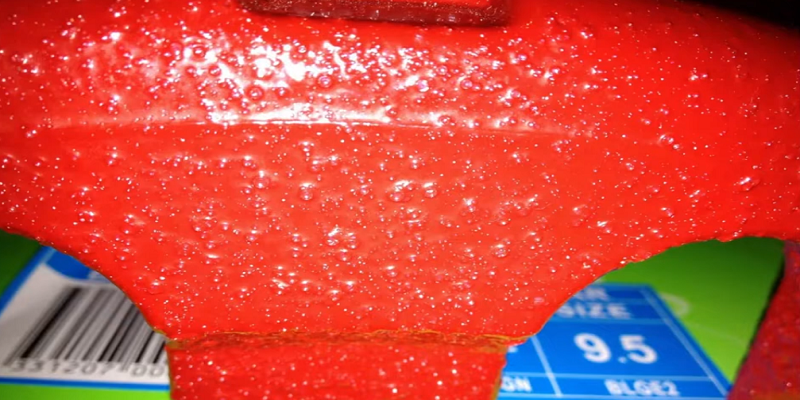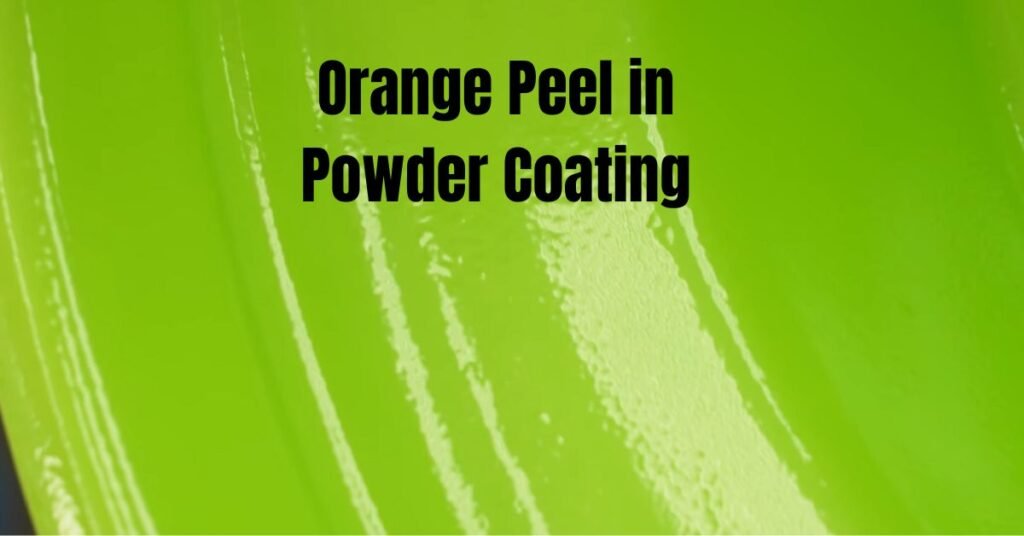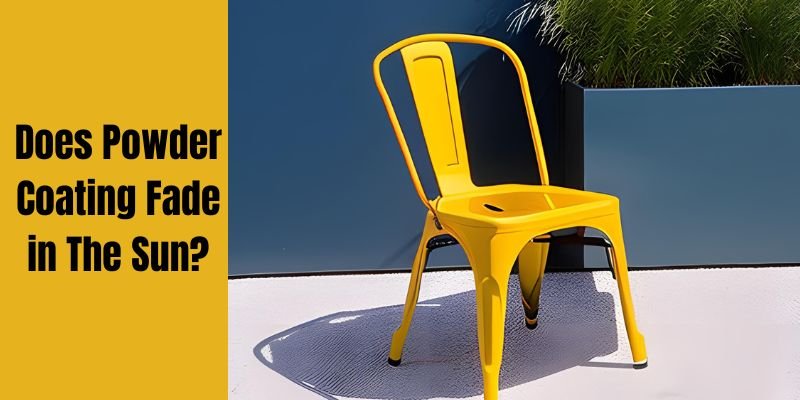Outgassing in powder coating refers to the release of trapped gases during the curing process. It can lead to defects such as bubbles and blisters in the final coat.
The process involves the heating of the powder coating, causing the trapped gases to expand and escape, leaving behind a smooth and durable finish. Powder coating is widely used for its excellent adhesion, corrosion resistance, and overall aesthetics in various industries including automotive, furniture, and aerospace.
To ensure successful powder coating, it is essential to properly prepare the substrate and control the curing temperatures to minimize the risk of outgassing and achieve a high-quality, defect-free finish.

Understanding The Basics Of Outgassing
Understanding the Basics of Outgassing
Outgassing is an important phenomenon to understand in the world of powder coating. When it comes to achieving a flawless finish, it’s crucial to have a clear understanding of what outgassing is and how it can impact the coating process. In this section, we will delve into the definition of outgassing, how it occurs during powder coating, and the role of temperature in this process.
Definition Of Outgassing
Outgassing, in the context of powder coating, refers to the release of trapped gases and other volatile elements from the surface of a substrate during the curing process. These substances can include solvents, water vapor, and other contaminants that have been trapped within the substrate material.
How Outgassing Occurs During Powder Coating
During the powder coating process, the substrate is preheated to a specific temperature. This preheating step helps to remove any surface moisture or solvents that may be present. However, despite this preheating, there can still be trapped gases lingering within the substrate.
As the powder coating material is applied and heated, these trapped gases are released. The heat causes the gases to expand, forcing them out of the substrate and towards the surface. This outgassing can create visible defects on the coated surface, such as bubbles or craters.
Role Of Temperature In Outgassing
Temperature plays a vital role in the outgassing process. When the substrate is heated to the prescribed temperature range, it allows the trapped gases to expand and escape from the surface. The appropriate temperature range for outgassing can vary based on the specific substrate and the type of contaminants present.
Too high a temperature can lead to excessive gas release and may result in defects on the finished coating. On the other hand, insufficient temperature can cause incomplete outgassing and result in trapped gases compromising the coating integrity. Therefore, it’s essential to follow the recommended temperature guidelines to ensure optimal outgassing and a high-quality powder coating finish.
In conclusion, outgassing is a critical aspect of the powder coating process that can significantly impact the quality of the final product. By understanding the definition of outgassing, how it occurs during powder coating, and the role of temperature in this phenomenon, manufacturers and applicators can take appropriate measures to minimize outgassing-related defects and achieve superior coating results.
Impacts Of Outgassing On Powder Coating
Outgassing, also known as vaporization or off-gassing, is a phenomenon that occurs during the powder coating process. It happens when trapped air or moisture within the substrate is released and tries to escape through the newly applied powder coating. While outgassing may seem like a minor concern, it can have significant impacts on the quality, appearance, and performance of powder coated surfaces. Understanding these impacts is crucial to ensure flawless and durable powder coating results.
Defects Caused By Outgassing
Outgassing can lead to various defects in powder coating, compromising the overall finish and visual appeal of the coated surface. Some of the typical defects caused by outgassing include:
Pinholes: These are tiny air bubbles that create small, crater-like openings on the coated surface. Pinholes not only detract from the smooth appearance of the coating but also increase the risk of corrosion over time as they expose the substrate to environmental factors.
Porosity: Outgassing can create porous spots in the coating, resulting in a rough and uneven texture. These porous areas are more prone to moisture infiltration, leading to potential coating failures and reduced durability.
Blistering: Outgassing can cause blister formation on the powder coating surface, where trapped air or moisture creates raised bubbles. Blistering not only affects the aesthetics of the coating but also weakens its adherence to the substrate, making it susceptible to chipping, peeling, and other damages.
Surface Imperfections And Delamination
Outgassing can also contribute to surface imperfections and delamination of the powder coating. When air or moisture escapes through the coating, it disrupts the smooth flow and adherence of the powder particles, resulting in:
Orange Peel Effect: Outgassing can cause an uneven, textured finish resembling the skin of an orange. This surface imperfection not only diminishes the overall aesthetics but also reflects light unevenly, making the coating appear dull or inconsistent.
Delamination: The escape of air or moisture through the powder coating can cause delamination, where the coating separates from the substrate. Delamination compromises the structural integrity of the coating, leading to potential failures and reduced longevity of the powder coated surface.
Effects On Coating Performance And Durability
Outgassing can have significant effects on the performance and durability of powder coating, impacting its ability to withstand the demands of various environments and applications. Some of the notable effects include:
Reduced Adhesion: As outgassing creates pockets of air or moisture within the coating, it can hinder proper adhesion between the coating and the substrate. This compromised adhesion weakens the protective properties of the coating, making it more susceptible to corrosion, scratches, and other forms of damage.
Decreased Film Thickness: Outgassing can lead to a reduction in the overall film thickness of the powder coating. This thinner coating not only compromises the aesthetic appeal but also reduces the coating’s ability to provide adequate protection against external factors, such as UV rays, chemicals, and physical abrasions.
Decreased Longevity: The defects and imperfections caused by outgassing ultimately contribute to a decreased lifespan of the powder coating. The weakened coating is more prone to degradation, chipping, flaking, and other forms of wear over time, reducing its durability and necessitating premature recoating.
It’s clear that outgassing can have significant negative impacts on powder coating, affecting both its appearance and performance. By taking appropriate measures to minimize outgassing, such as proper surface preparation, temperature control, and using suitable application techniques, professionals can ensure high-quality, durable powder coated finishes that stand the test of time.
Factors Affecting Outgassing
Outgassing is a critical consideration in powder coating processes as it can lead to defects such as bubbles, blisters, or fish-eyes on the coated surface. To ensure a high-quality finish, it is essential to understand the factors that can affect outgassing. These factors include:
Substrate Material And Surface Preparation
The type of substrate material and the quality of its surface preparation play a crucial role in outgassing. Different materials have varying levels of porosity and gas absorption, which can affect the release of trapped gas during the curing process. Substrates with high porosity, such as cast iron or zinc, are more prone to outgassing.
The surface preparation, including cleaning, degreasing, and roughening, helps remove contaminants and provide better adhesion for the powder coating. Proper surface preparation reduces the chances of outgassing by eliminating trapped gases and impurities.
Powder Coating Composition
The composition of the powder coating itself can influence outgassing. The choice of resins, fillers, and additives in the powder formulation can impact the release of trapped gases. Certain additives may increase the volatility of the coating, leading to higher outgassing potential. It is crucial to select a powder coating with low outgassing properties to minimize defects. Additionally, using a powder coating with a higher degree of crosslinking can help improve its resistance to outgassing.
Curing Process And Temperature
The curing process and temperature are critical factors affecting outgassing. During the curing process, the powder coating undergoes a phase change, transforming from a powder to a solid film. The release of trapped gas occurs during this phase change. The temperature at which the curing takes place influences the rate at which gas is released.
Higher curing temperatures may result in faster outgassing, but it is essential to balance the temperature to avoid rapid gas release leading to defects. The curing time should also be optimized to allow sufficient gas release without compromising the coating’s performance.
These three factors – substrate material and surface preparation, powder coating composition, and curing process and temperature – all play vital roles in outgassing during the powder coating process. By understanding and carefully considering these factors, you can minimize defects and ensure a high-quality finish for your powder-coated products.
Prevention And Control Of Outgassing
When it comes to powder coating, preventing and controlling outgassing is crucial for achieving a high-quality and durable finish. Outgassing, the release of trapped gases from the substrate during the curing process, can cause a range of issues such as surface defects and adhesion problems. By ensuring a clean surface, selecting suitable powder coating, and applying proper drying and curing techniques, you can effectively prevent and control outgassing in powder coating.
Importance Of Clean Surface
A clean surface plays a vital role in preventing outgassing in powder coating. Before the coating process, it is essential to thoroughly clean the substrate to remove any dirt, oil, grease, or other contaminants. This can be done using solvents, degreasers, or appropriate cleaning agents. Clean surfaces not only prevent the entrapment of gases but also facilitate better adhesion between the substrate and the powder coating.
Selection Of Suitable Powder Coating
Selecting the right powder coating is paramount in the prevention of outgassing. There are various factors to consider, including the type of substrate, the intended application, and the curing temperature. For example, using a powder coating with a low curing temperature can help minimize the release of trapped gases. Additionally, powder coatings that have been specifically formulated to reduce outgassing can be beneficial in achieving a smoother and defect-free finish.
Proper Drying And Curing Techniques
Applying proper drying and curing techniques is essential in controlling outgassing during the powder coating process. It is crucial to follow the manufacturer’s guidelines regarding the recommended curing temperature and time. Proper preheating and curing provide sufficient time for the release of trapped gases, reducing the occurrence of surface defects. Moreover, ensuring a consistent and uniform curing process helps to promote better adhesion and long-term durability of the powder coating.
Testing And Quality Assurance For Outgassing
Testing and quality assurance for outgassing in powder coating is crucial to ensure the durability, functionality, and appearance of coated products. Outgassing, which refers to the release of trapped gases during the curing process, can lead to various issues such as blistering, bubbles, or poor adhesion. To prevent these problems, proper testing methods, adherence to industry standards and guidelines, and a focus on ensuring consistent quality are essential.
Outgassing Testing Methods
When it comes to testing for outgassing in powder coating, several methods are commonly utilized. Each method aims to determine the level of gas emission from the coating and assess its potential impact on the final product. Some of the widely used testing methods include:
Dynamic Outgassing: This method involves subjecting the coated material or product to controlled heating and cooling cycles, simulating the actual conditions it may encounter during its lifecycle. The released gases are then measured and analyzed to evaluate their impact.
Thermal Desorption Analysis: By using this technique, the volatile substances within the coating are heated, causing the gases to be released and subsequently analyzed. This method helps in identifying the specific gas species and their concentrations, providing valuable insights into the coating’s outgassing behavior.
Gas Chromatography/Mass Spectrometry (GC/MS): GC/MS enables the detection and identification of the gases emitted from the coating by separating and quantifying individual gas components. This method allows for detailed analysis, giving manufacturers a deeper understanding of the outgassing characteristics.
Industry Standards And Guidelines
When it comes to outgassing in powder coating, industry standards and guidelines play a critical role in ensuring the quality and performance of the coated products. These standards, such as those set by the American Society for Testing and Materials (ASTM) and the Society of Automotive Engineers (SAE), provide specific criteria for outgassing limits and acceptable levels. Adhering to these standards not only ensures consistency in quality but also helps manufacturers meet customer expectations and comply with regulatory requirements.
Ensuring Quality And Consistency
Manufacturers place great emphasis on maintaining the quality and consistency of powder coating finishes, including minimizing the outgassing effect. To achieve this, they employ various measures, such as:
Raw Material Selection: Using high-quality raw materials that have undergone thorough testing and meet industry standards can significantly reduce the occurrence of outgassing issues.
Process Optimization: Careful control of temperature, curing time, and other process parameters can help mitigate outgassing problems. Process optimizations and parameter adjustments are carried out to ensure consistency and minimize the release of trapped gases.
Regular Testing and Monitoring: Continuous testing and monitoring throughout the manufacturing process are crucial to detect and rectify any outgassing issues early on. By regularly assessing coating samples and using advanced testing methods, manufacturers can maintain quality and address any deviations promptly.
Employee Training: Well-trained and knowledgeable personnel play a vital role in ensuring the quality of powder coating finishes. Proper training on handling raw materials, following manufacturing guidelines, and implementing rigorous quality control measures can contribute to consistent and reliable outcomes.
By employing these testing methods, adhering to industry standards, and prioritizing quality and consistency, manufacturers can effectively address the challenges of outgassing in powder coating. Ultimately, this leads to enhanced product performance, customer satisfaction, and a reputation for delivering superior coatings.
Final Words
Understanding the concept of outgassing in powder coating is crucial for achieving high-quality results. By knowing the causes and implications of outgassing, professionals can take necessary precautions to prevent any issues during the coating process. From selecting the right powder to ensuring proper ventilation, addressing outgassing concerns is essential for a successful powder coating application.
By implementing the right techniques, businesses can deliver outstanding finishes and long-lasting coatings to their customers, ultimately achieving customer satisfaction and maintaining a competitive edge in the industry.


